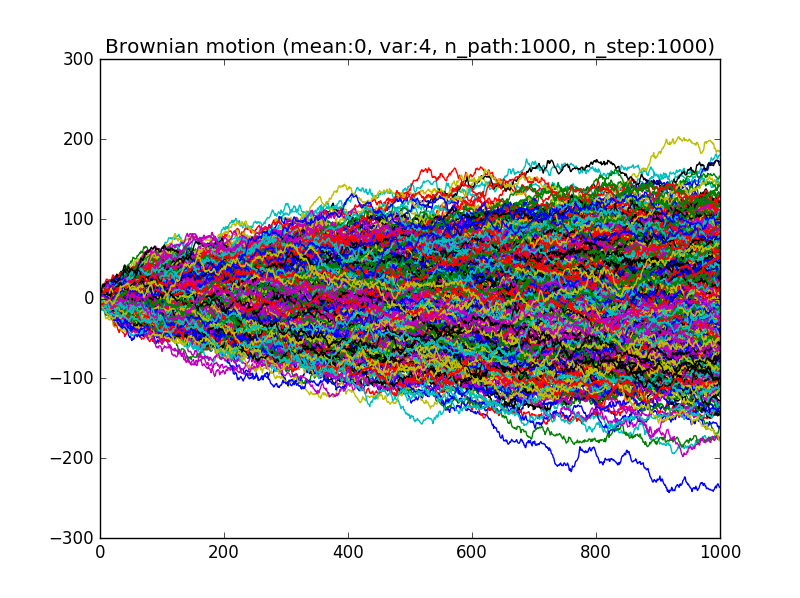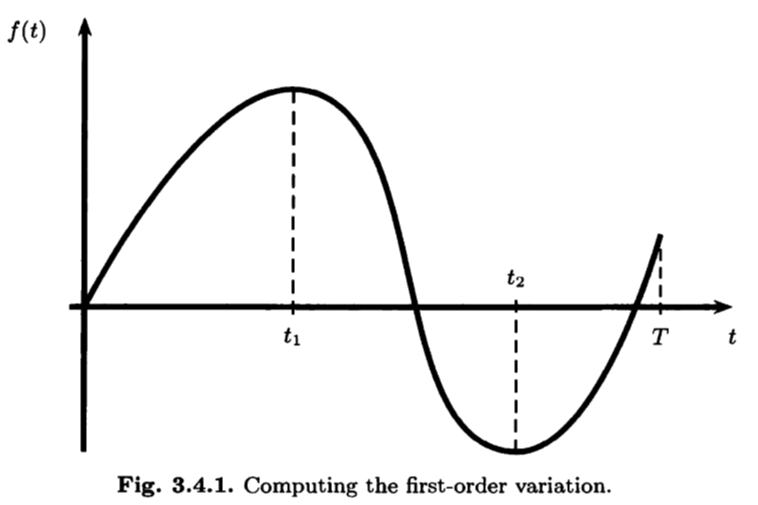Brownian motion (布朗運動)
定義: Brownian motion
定義 (in Shreve, Stochastic Calculus for finance)
- (Ω,F,P) is probability space.
- For each ω∈Ω, suppose there is a continuous function W(t), t≥0, which satisfies W(0)=0 and depends on ω.
- Then W(t), t≥0 is Brownian process if ∀0=t0<t1<⋯<tn, the increment W(t1)−W(t0), W(t2)−W(t1), \cdots W(tn)−W(tn−1 are mutual independent.
- Each of the increment is i.i.d. random variable of N(0,ti+1−ti)
- E(W(ti+1)−W(ti))=0.
- Var(W(ti+1)−Wti)=ti+1−ti.
- ∴W(t)=W(t)−W(0)∼N(0,t).
Filtration
- (Ω,F,P) is probability space, and Brownian process W(t), t≥0.
- A filtration for Brownian process is a collection of σ-field F(t), t≥0 satisfies:
- Information accumulates (增大資訊集合), 0≤s≤t, F(s)⊆F(t).
- There is at least much information available at the later time F(t) as there is at the earlier time F(s).
- 資訊為擴增的集合。
- Adaptivity (適應性), ∀t≥0, {w∣W(t,ω)}∈F(t) or called W(t) is F(t)-measurable.
- The information available at time t is sufficient to evaluate the Brownian process W(t) at this time.
- 現在的事件必須可以用到目前為止的資訊集合評估。
- Independence of future increment, 0≤s≤t, P(W(t)−W(s)∣F(s))=P(W(t)−W(s)).
- Any increment of the Brownian process after time t is independent of the information available at time t.
- 未來的事件與現在的資訊集合獨立,即無法預測Brownian過程未來之值。
- Properties (1) and (2) guarantee that the information available at teach time t is at least as much as one would learn from observing the Brownian motion up to time t.
- There are two possibilities for the filtration F(t) for Brownian process.
- F(t) contains only the information obtained by observing the Brownian process itself up time t.
- If the information F(t) includes observations of processes other than Brown process W(t), this additional information is not allow to give clues about the future increments of W because of the property (3).
Implementation
import numpy as np
import matplotlib.pyplot as plt
def brownian_motion(n_path, n_step=1000, mean=0, variance=1):
points = np.random.randn(n_path, n_step)*np.sqrt(variance) + mean
return(np.cumsum(points, axis=1))
n_path, n_step, mean, variance = 1000, 1000, 0 , 4
paths = brownian_motion(n_path, n_step, mean, variance)
for rdx in xrange(n_path):
plt.plot(paths[rdx])
plt.title("Brownian motion (mean:{}, var:{}, n_path:{}, n_step:{})".format(
mean, variance, n_path, n_step))
plt.show()

標準布朗運動性質
B(t)∼N(0,t).
{B(t),t ≥0} are a standard Brownian process,0<s<t,a,b∈R.
- Cov(B(s),B(t))=E(B(s),B(t))=s,∀s≤t.
∵Cov(B(s),B(t))====Cov(B(s),B(s)+B(t)−B(s))Cov(B(s),B(s))+Cov(B(s),B(t)−B(s))[indep. incr.]Cov(B(s),B(s))+0s.
- Var(B(s)−B(t))=t−s, Var(B(t))=t.
- Var(aB(s)+bB(t))=(a+b)2s+b2(t−s).
∵Var(aB(s)+bB(t))====Var(aB(s)+b(B(s)+B(t)−B(s)))Var((a+b)B(s)+b(B(t)−B(s)))Var((a+b)B(s))+Var(b(B(t)−B(s))[indep. incr.](a+b)2s+b2(t−s).
- aB(s)+bB(t)∼ normal distribution.
- Covariance matrix of (W(t1),W(t2),⋯,W(tn)) is
⎣⎡E(W2(t1))⋮E(W(tn)W(t1))⋯⋱⋯E(W(t1)W(tn))⋮E(W2(tn))⎦⎤
The density function
- ft(x)=√2πt1e−2tx2.
The joint pdf
f(x1,x2,⋯,xn)==ft1(x1)ft2(x2−x1)⋯ftn−tn−1(xn−xn−1)(2π)n/2[t1(t2−t1)⋯(tn−tn−1)]1/21exp{−21[t1x12+t2−t1(x2−x1)2+⋯+tn−tn−1(xn−xn−1)2]}
Conditional distribution
Covariance
X(t), t≥0 is Brownian process, X(t)∼N(0,σ2t).
- 0<s<t, Cov(X(s),X(t)=σ2s.
Cov(X(s),X(t))=====E(X(s)X(t))E(X(s)(X(s)+X(t)−X(s)))Var(X(s))+Cov(X(s),X(t)−X(s))Var(X(s))σ2s.
- Generally, Cov(X(s),X(t))={σ2min(∣s∣,∣t∣)0st>0,st<0.
Correlation
- Corr(X(s),X(t))=√st, 0<s<t.
Corr(X(s),X(t))===√Var(X(s))Var(X(t))Cov(X(s),X(t))√σ2sσ2tσ2s√st.
平賭(鞅)(Martingle process)
(Ω,F,Fn,P) be a probability space, and Fn is a flitration.
- If X(t)∈Ft-measurable, E(∣X(t)∣)<∞, and
- X(t)=E(X(t+1)∣Ft).
- then X is a martingale process.
X(t) is a Brownian process, X(t)∼N(0,σ2t), the following are martingale processes:
- X(t)
- X2(t)−σ2t
- (Exponential martingale process) exp{μX(t)−2μ2σ2t}, μ∈R.
X(t) is martingale process.
0<s<t, X(t)=X(t)−X(s)+X(s).
E(X(t)∣F(s))(∵X(t)−X(s) indep. to Fs)====E(X(t)−X(s)+X(s)∣F(s))E(X(t)−X(s)∣F(s))+E(X(s)∣F(s))E(X(t)−X(s))+X(s)X(s).
X2(t)−σ2t is martingale process.
X2(t)==(X(t)−X(s)+X(s))2(X(t)−X(s))2+2X(s)(X(t)−X(s))+X2(s)
E((X(t)−X(s))2∣Fs)=E((X(t)−X(s))2)=(t−s)σ2.
E(X2(s)∣Fs)=X2(s).
∴E(X2(t)−σ2t∣Fs)=(t−s)σ2+X2(s)−σ2t=X2(s)−σ2s.
exp{μX(t)−2μ2σ2t}, μ∈R. is martingale process.
- μX(t)=μ(X(t)−X(s))+μX(s).
- E(exp(μX(t))∣Fs)=exp(μX(s))⋅E(exp(μ(X(t)−X(s)))).
∵ X(t)−X(s)∼N(0,(t−s)σ2),
- the mgf E(exp(μ(X(t)−X(s)))=exp(2μ2(t−s)σ2).
∴E(exp(μX(t)−2μ2σ2t)∣Fs)==exp(μX(s)+2μ2(t−s)σ2−2μ2σ2t)exp(μX(s)−2μ2σ2s).
Shift property
X(t), t≥0 is Brownian motion, X(t)∼N(0,σ2t).
- ⇒ Y(t)=X(t+r)−X(r), ∀r∈R is Brownian process.
E(Y(t))=E(X(t+r)−X(r))=E(X(t+r))−E(X(r))=0.
Cov(Y(t),Y(s))=σ2min(t,s).
Cov(X(t),X(s))=====E(X(t)X(s))E((X(t+r)−X(r))(X(s+r)−X(r))E(X(t+r)X(s+r))−E(X(t+r)X(r))−E(X(r)X(s+r))+E(X2(r))σ2min(t+r,s+r)−σ2r−σ2r+σ2σ2min(t,s).
Y(t) is normal distribution.
Scaling property
X(t), t≥0 is Brownian motion, X(t)∼N(0,σ2t).
- ⇒ Y(t)=cX(c2t), ∀c>0 is Brownian process.
- E(Y(t))=0.
Cov(Y(t),Y(s))=σ2min(t,s).
Cov(X(t),X(s)===c−2E(X(c2t)(c2s))σ2c−2min(c2t,c2s)σ2min(t,s).
- Y(t) is normal distribution.
Brownian motion with drift
前面討論的Brownian motion都是沒有趨勢,即E(X(t))=0, ∀t.
X(t), t≥0 is Brownian process with drift coefficient μ and variance parameter σ2 if
- X(0)=0.
- X(t), t≥0 has stationary and independent increments.
* X(t)∼N(μt,σ2t).
等價定義, B(t), t≥0 is standard Brownian process and X(t)=σB(t)+μt.
Geometric Brownian proces
- Y(t), t≥0 is Brownian process, and Y(t)∼N(μt,σ2t).
Defintion: Geometric Brownian motion
- X(t)=eY(t), t≥0.
- i.e. lnX(t)=Y(t)∼N(μt,σ2t).
E(X(t)∣X(u),0≤u≤s)=X(s)E(eY(t)−Y(s)).
E(X(t)∣X(u),0≤u≤s)(∵indep. incr.)====E(eY(t)∣X(u),0≤u≤s)E(eY(t)−Y(s)+Y(s)∣X(u),0≤u≤s)eY(s)E(eY(t)−Y(s)∣X(u),0≤u≤s)X(s)E(eY(t)−Y(s)).
Standard Brownian bridge process
Standard Brownian bridge process為起點與終點在相同位置的隨機過程。
B(t), t≥0 is standard Brownian process, B(t)∼N(0,t).
Let Y(t)=B(t)−tB(0), 0≤t≤1.
- Y(0) = B(0) - 0 B(1) = 0.
- Y(1) = b(1) - B(1) = 0‧
- Standard Brownian bridge from Y(0)=0 to Y(1)=0.
Standard Brownian bridge process properties
- E(Y(t))=E(B(t)−tB(0))=0.
Cov(Y(t),Y(s))=s(1−t), 0<s<t<1.
Cov(Y(t),Y(s))====Cov(B(t)−tB(1),B(s)−sB(1))Cov(B(t),B(s))−sCov(B(1),B(t))−tCov(B(s),B(1))+stCov(B(1),B(1))s−st−st+sts(1−t).
Brownian bridge process
B(t), t≥0 is standard Brownian process, B(t)∼N(0,t).
Process start from a at time t=0, achieve to b at t=T.
* Y(t)=a(1−Tt)+bTt+(B(t)−TtB(t)), 0≤t≤T.
* {% math %}Y(0) = a{% endmath %}.
* {% math %}Y(T) = b{% endmath %}.
- E(Y(t))=a(1−Tt)+bTt.
Var(Y(t))=t(1−Tt).
Var(Y(t))====E(B(t)−TtB(t))2E2(B(t))−T2tE(B(t)B(T))+T2t2E2(B(T))y−T2t2+T2t2Tt(1−Tt).
First-order variation

- 上圖中,依點t1, t2至T的函數變動量為FVT(f)=(f(t1)−f(t0))+(f(t2)−f(t1))+(f(T)−f(t2))=∫0t1f′(t)dt+∫t1t2−f′(t)dt+∫t2Tf′(t)dt=∫0T∣f′(t)∣dt.
- Let partition π={t0,t1,⋯,tN} of [0,T], and δ=max0≤k≤N(tk+1−tk).
- Define FVT(f)=limδ→0∑k=0N−1∣∣f(tk+1)−f(tk))∣∣.
- By mean-value-theorem (MVT) of derivative
- ∃k∈tk∗∈[tk,tk+1]∋tk+1−tkf(tk+1)−f(tk))=f(1)(tk∗).
- ∴f(tk+1−f(tk))=f(1)(tk∗)(tk+1−tk).
- ∑k=0N−1f(tk+1)−f(tk)=∑k=0N−1∣∣f(1)(tk∗)∣∣(tk+1)−tk).
- ∴limδ→0∑k=0N−1∣∣f(tk+1)−f(tk)∣∣=limδ→0∑k=0N−1∣∣f(1)t(k∗)∣∣(tk+1−tk)=∫0T∣∣f(1)(tk∗)∣∣dt.
- ∴FVT(f)=∫0T∣∣f(1)(tk∗)∣∣dt. (QED)
Quadratic variation
- The quadrativ variation of fucntion f up to time T is
[f,f](T)=δ→0limk=0∑N−1(f(tk+1)−f(tk))2
- Suppose f∈C1([0,T]) (i.e. f has a continuous 1st derivative)
∑k=0N−1(f(tk+1)−f(tk))2≤δ∑k=0N−1∣∣f(1)(tk∗)2∣∣(tk+1−tk).
[f,f](T)≡≤==δ→0limk=0∑N−1(f(tk+1)−f(tk))2δ→0lim(δk=0∑N−1∣∣f(1)(tk∗)2∣∣(tk+1−tk))δ→0limδδ→0limk=0∑N−1∣∣f(1)(tk∗)2∣∣(tk+1−tk)δ→0limπ∫0T∣∣f(1)(t)∣∣2dt
If limδ→0π∫0T∣∣f(1)(t)∣∣2dt≤∞ then [f,f](T)=0.
If limδ→0π∫0T∣∣f(1)(t)∣∣2dt→∞, then [f,f](T) diverges.
Brownian process is continuous, but not differentiabl everywhere, therefore the MVT is failed!!

